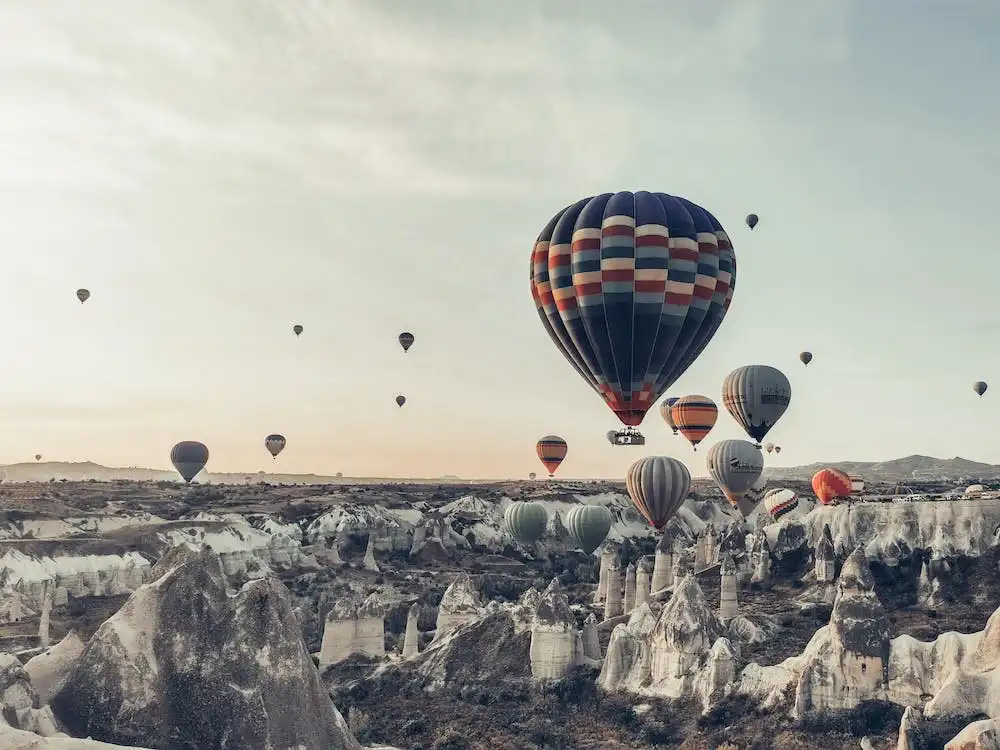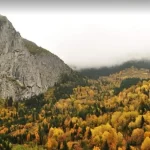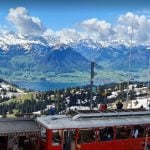Cappadocia
Cappadocia is a unique and fascinating region located in the center of Turkey. Cappadocia is known for its beautiful and otherworldly landscapes such as fairy chimneys, cave houses and underground cities. The region where Cappadocia is located has been included in the UNESCO World Heritage List and this has made Cappadocia a popular tourism center.
The unique geological formations of the Cappadocia region were formed by volcanic eruptions that occurred millions of years ago. These eruptions caused the soft tuff (compressed volcanic ash) to transform into fairy chimneys, cave houses and other unique formations found in Cappadocia today. This soft tuff found in Cappadocia also made it easy for people to carve houses, churches and even entire cities into the rock.
Cappadocia has a rich history dating back to the Hittites, Persians, Romans, Byzantines, Seljuks and Ottomans. The area was also an important center of early Christianity, with many rock churches and monasteries built into tuff formations. The most famous of these is the Göreme Open Air Museum, which includes many rock churches and frescoes dating back to the 10th century.
Cappadocia is also known for its hot air balloon rides, which offer a unique and scenic way to experience the sights of the region. Balloons typically take off at dawn, allowing visitors to see the sunrise over fairy chimneys and other unique rock formations.
Besides its natural beauty and rich history, Cappadocia is also home to a vibrant local culture. The area is known for its traditional pottery and textiles, as well as delicious local cuisine. Visitors can also experience the traditional Turkish bath or “hamam”, which has been a part of Cappadocia culture for centuries.

History Of Cappadocia
Cappadocia is a historical and cultural region located in the center of Turkey. The region has a rich and complex history dating back to ancient times.
The earliest known inhabitants of Cappadocia were the Hittites, an ancient Anatolian people who established a powerful empire in the region around 1600 BC. The Hittites built a network of roads and fortifications throughout the region. The influence of the built structures can still be seen in the many rock temples and underground cities that punctuate the landscape.
After the fall of the Hittite Empire, Cappadocia was ruled by a number of different peoples, including Persians, Macedonians, and Romans. The Romans founded the state of Cappadocia in 17 AD. Afterwards, Cappadocia remained an important center of Roman culture and politics for centuries.
In the Byzantine period, Cappadocia was an important center of Christianity. For this reason, many churches, monasteries and other religious buildings were built in the region. The most famous of these works is the Göreme Open Air Museum, which includes many rock churches and frescoes dating back to the 10th century.
Cappadocia, which then came under the control of the Seljuk Turks in the 13th century, remained a part of the Ottoman Empire until the collapse of the empire in the early 20th century.
Today, Cappadocia is a popular tourist destination known for its unique and out-of-this-world scenery as well as its rich history and culture.
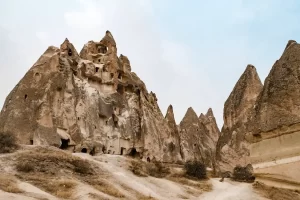
Where Does the Name of Cappadocia Come From?
It is believed that the name “Cappadocia” comes from the ancient Persian word “Katpatuka” meaning “land of beautiful horses”. It is thought that the name of the region was given by the Persian Empire, which controlled the region in the 6th century BC.
Another theory is that the name “Cappadocia” comes from the Greek word “Kappadokia” meaning “land of beautiful, well-dressed people”. This name is BC. It is thought that it was given by the Greeks, who settled in the region in the 4th century and took its name from the local people known for their beauty and fine clothing.
Another theory is that the name “Cappadocia” comes from the Hittite language, which is thought to have been spoken in the region before the Persians and Greeks arrived. According to this theory, the name “Cappadocia” derives from the Hittite word “Katpatuka” meaning “land of beautiful people”.
It is important to note that the origin of the name is uncertain and there are different theories of etymology.
It is generally believed that the name Cappadocia comes from the ancient Persian word “Katpatuka” meaning “land of beautiful horses” or the Greek word “Kappadokia” meaning “land of beautiful, well-dressed people”.
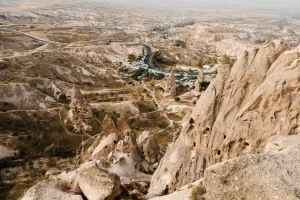
Where is Cappadocia?
Cappadocia is a region located in the center of Turkey. It is located in the east of the Central Anatolia Region, which is the central part of the country. Cappadocia is bordered by the provinces of Kayseri in the west, Aksaray in the south, Niğde in the southeast and Nevşehir in the east. The closest major city to Cappadocia is the city of Nevşehir, which is the center of the region. The closest airport to Cappadocia is Kayseri Erkilet Airport, which is also the closest major airport to the region. Please click for the location of Cappadocia on the map
In Which Month To Go To Cappadocia?
The best time to visit Cappadocia depends on what you want to see and do while you are there.
Spring (April – June) is a great time to visit Cappadocia as the weather is mild and the landscape is green and lush. The wildflowers have also bloomed and make a beautiful sight. This is also the season when hot air balloons are in the sky, a popular activity in Cappadocia.
Summer (July – September) is a good time to visit Cappadocia as the weather is hot and dry. However, it can be quite hot during the day, so it’s best to plan your activities for the cooler hours of the morning and evening. This season is also great for hiking and outdoor activities.
Autumn (October – November) is a great time to visit Cappadocia as the weather is mild and the landscape takes on beautiful shades of red, orange and yellow. It’s also a good time to see hot air balloons, as the sky is clear and visibility is excellent.
Winter (December – March) can also be a good time to visit Cappadocia, as the crowds are usually less and prices are lower. However, it can be quite cold at night and some outdoor activities and tours may not be available due to the cold weather.
In general, any season can be a good time to visit Cappadocia, depending on your preferences and what you want to see and do while you are there.
Places to Visit in Cappadocia
Cappadocia is home to many unique and interesting places to visit, here are a few popular options:
Göreme Open Air Museum: Cappadocia is a UNESCO World Heritage site that contains a collection of rock churches and monasteries dating back to the early Christian period. The museum houses some of the best preserved frescoes in Cappadocia and offers a glimpse into the early Christian lifestyle in the area.
Uçhisar Castle: It is a large fairy chimney rock formation carved into the castle. Visitors can climb to the top of the castle for panoramic views of the surrounding landscape.
Derinkuyu Underground City: It is one of the largest underground cities of Cappadocia, carved into soft tuff rock, and used as a shelter during times of war and occupation.
Ihlara Valley: It is a long and narrow valley with many rock churches and monasteries. Visitors can hike or take a boat trip through the valley to explore the ancient structures and enjoy the natural beauty of the area.
Zelve Open Air Museum: This is another UNESCO World Heritage site with a collection of rock houses and churches dating back to the early Christian period. Known for its well-preserved frescoes, the museum offers a glimpse into the traditional way of life in Cappadocia.
Devrent Valley: Also known as “Imagination Valley”, the different shapes of fairy chimneys and a great place for photography enthusiasts.
Avanos: A town on the banks of the Kızılırmak, known for its traditional pottery and is a good place to learn the traditional pottery making techniques of the region and to buy souvenirs.
Hot Air Balloon Tour Area: It is one of the most popular activities in Cappadocia, offering breathtaking views of fairy chimneys, rock formations and valleys.
What Is Cappadocia Famous For?
Cappadocia is famous for its unique and otherworldly landscapes shaped by volcanic activity and erosion over millions of years. This region is known for its fairy chimneys, cave houses, underground cities and other geological formations. Some of the most popular properties of Cappadocia are:
Fairy Chimneys: They are long, cone-shaped rock formations unique to Cappadocia. They are formed by erosion and are made of soft tuff (compressed volcanic ash).
Cave Houses: Most of the inhabitants of Cappadocia have carved their houses and churches into soft tuff rocks. Today, these cave houses can be visited and some of them are still inhabited.
Underground Cities: Cappadocia is home to several underground cities carved into soft tuff rock. These cities were used as shelters in times of war and occupation.
Hot Air Balloon Rides: Hot air balloon rides are a popular activity in Cappadocia and provide a unique and scenic way to experience the sights of the region.
Rock-Carved Churches and Monasteries: Cappadocia is home to many rock-cut churches and monasteries carved into soft tuff rock. Many of these ancient structures are still standing and open to visitors today.
Traditional Turkish Baths: Turkish baths or “hamams” have been a part of Cappadocia culture for centuries. Visitors to Cappadocia can experience the traditional Turkish bath in Cappadocia.
Local Pottery and Textile Arts: Cappadocia is known for its traditional pottery and textiles, often made using techniques handed down from generation to generation.
Local Cuisine: The region is also known for its delicious local cuisine, which is mainly influenced by the traditional dishes of the Central Anatolia region.
What Activities Can Be Done In Cappadocia?
Cappadocia is a unique and diverse area that offers a wide variety of activities for visitors to enjoy. Here are a few popular activities to consider:
Hot Air Balloon Ride: One of the most popular activities in Cappadocia is the hot air balloon ride. This is a great way to see the area from a different perspective, taking in the stunning scenery, fairy chimneys and cave houses.
Hiking and Trekking: Cappadocia is a great place for hiking and trekking, with many trails that take you through beautiful scenery of valleys, canyons, and rock formations. Depending on your fitness level, you can choose between easy, moderate or strenuous trails.
Cave Exploration: Cappadocia is famous for its cave houses, and you can explore these caves by visiting the Open Air Museum in Göreme or by taking a guided tour of the underground cities.
Horseback Riding: Another great way to explore Cappadocia is by horseback riding. There are many companies that offer guided horseback riding tours, and this is a great way to see more remote and less-visited parts of the area.
ATV and Jeep Tours: For a more adventurous experience, you can take an ATV or Jeep tour in Cappadocia. These tours take you off-road and into the more rugged and remote areas of the region.
Visiting Local Wineries: Cappadocia is also known for its wine production, and you can visit local wineries to taste and learn about different wines.
Visiting Local Workshops: Cappadocia is also known for its traditional arts and crafts, such as pottery, carpet weaving, and onyx stonework. You can visit local workshops to see artisans at work and buy souvenirs.
Spa and Wellness: Many hotels and cave hotels have spa and wellness centers that offer traditional Turkish baths, massages and other beauty treatments.
Turkish Night in
Turkish Night is a popular activity in Cappadocia. It is an evening event that usually includes traditional Turkish food, music and dance performances. Performances often include traditional Turkish folk music, belly dancing and whirling dervish (Sufi dance). Many hotels and tour companies in Cappadocia offer Turkish Night as an option for their visitors to experience local culture and entertainment.
During the night, you will have the opportunity to taste delicious traditional Turkish dishes such as dolma (stuffed leaves), meatballs (meatballs) and pilaf (rice dish) accompanied by local wines and raki (anise-flavored liqueur). You will also have the chance to watch traditional dances and musical performances, which are usually colorful, lively and entertaining.
The night usually starts with dinner and drinks, followed by dance performance and music. Some nights include a traditional whirling dervish performance, a spiritual dance believed to bring the dancer closer to God. It is a great way to spend an evening in Cappadocia and a great way to experience the local culture and traditions of Turkey.
Is There a Legend ?
Cappadocia is a region with a rich history and culture, and there are many legends and stories about it. Here are a few legends passed down through the ages:
Legend of the Fairy Chimneys: Legend has it that the fairy chimneys, the tall, cone-shaped rock formations found all over Cappadocia, were created by a powerful and benevolent fairy queen who protected the locals from harm. She created fairy chimneys as a shelter for people to take shelter in times of danger.
Fairy Legend: A popular legend that tells the story of a beautiful fairy who falls in love with a mortal man. The two were not allowed to be together, so the fairy turned herself into a rock formation to be near her lover. It is said that the rock formation resembles a woman’s face and if a wish is made there, the wish will come true.
It is important to note that these myths are not scientifically proven and have only been passed on over time.
Where Does Cappadocia’s Name Come From?
It is believed that the name “Cappadocia” comes from the ancient Persian word “Katpatuka” meaning “land of beautiful horses”. It is thought that the name of the region was given by the Persian Empire, which controlled the region in the 6th century BC.
Another theory is that the name “Cappadocia” comes from the Greek word “Kappadokia” meaning “land of beautiful, well-dressed people”. This name is BC. It is thought that it was given by the Greeks, who settled in the region in the 4th century and took its name from the local people known for their beauty and fine clothing.
Another theory is that the name “Cappadocia” comes from the Hittite language, which is thought to have been spoken in the region before the Persians and Greeks arrived. According to this theory, the name “Cappadocia” derives from the Hittite word “Katpatuka” meaning “land of beautiful people”.
It is important to note that the origin of the name is uncertain and there are different theories of etymology. It is generally believed that the name Cappadocia comes from the ancient Persian word “Katpatuka” meaning “land of beautiful horses” or the Greek word “Kappadokia” meaning “land of beautiful, well-dressed people”.
What is the Importance of Cappadocia for Christianity?
Cappadocia is an important region for Christianity as it has a rich history dating back to the early days of the religion. The area was an important center of early Christianity and was home to many early Christian communities, including those led by St. Paul and St. Basil the Great.
In the first centuries of Christianity, the area was a place of refuge for those fleeing the persecution of the Roman Empire. Many Christians took refuge in the region’s unique geological features, such as fairy chimneys, caves, and underground cities that provided natural shelter and concealment. This area was also a popular destination for early Christian monks and hermits who carved caves and underground dwellings for seclusion.
The area is home to many historical sites and monuments, such as the Göreme Open Air Museum, St. Basil’s Monastery, the underground cities of Kaymaklı and Derinkuyu, and many early Christian rock churches and chapels. These sites are important not only for their historical and architectural significance, but also as a testament to the resilience and determination of the early Christians in the face of persecution.
Also, Cappadocia is a place of pilgrimage for many Christians today, especially the Greek Orthodox Church.
In general, Cappadocia is an important region for Christianity due to its historical and cultural significance as well as its spiritual significance for many Christians today.
How Can We Go To ?
There are several ways to go to Cappadocia, depending on your location and your budget. Here are a few options:
By Plane: The closest airport to Cappadocia is Nevşehir Cappadocia Airport, located just outside the Nevşehir district. The airport is well connected to major cities in Turkey and there are direct flights from Istanbul, Ankara and Izmir. Some international airlines also have direct flights from different countries to Nevşehir Cappadocia Airport.
By Bus: If you are already in Turkey, you can reach Cappadocia by bus from major cities such as Istanbul, Ankara and Konya. The bus journey takes 8-10 hours from Istanbul and 5-6 hours from Ankara.
By Train: The closest train station to Cappadocia is in Kayseri and you can reach Cappadocia by bus or taxi from here. The train journey takes 8-10 hours from Istanbul and 4-5 hours from Ankara.
By Car: If you have a car, you can go to Cappadocia. It takes about 12-14 hours by car from Istanbul and about 4-5 hours by car from Ankara.
By Taking A Tour: If you choose to join a tour, you can find many tour companies that offer organized tours to Cappadocia, including transportation, accommodation and guided tours of the region.
The best time to visit Cappadocia depends on what you want to see and do during your trip, but in general the best time to visit is between April and October when the weather is warm and the skies are clear. It’s also worth noting that hot air balloon rides only take place in good weather conditions, so if you’re planning to go on a hot air balloon ride, it’s best to plan your trip during the summer months.
Where Can We Stay In ?
Cappadocia is home to a wide variety of accommodation options to suit all budgets and preferences, here are a few popular options:
Hotels: There are many hotels in Cappadocia, from budget-friendly options to luxury resorts. There are many hotels in the towns of Göreme, Ürgüp and Uçhisar, which are the main touristic areas of Cappadocia.
Cave hotels: Cappadocia is famous for its cave houses, and you can stay in a cave hotel and experience accommodation in one of these traditional houses. Carved into soft tuff rocks, these hotels offer a unique and authentic experience.
Guesthouses: There are many guesthouses in Cappadocia that offer a more traditional and homely atmosphere. These guesthouses are often run by local families and provide a great opportunity to experience local hospitality.
Camping: There are many campsites in Cappadocia that are a great option for budget travelers and outdoor enthusiasts.
Luxury resorts: There are also some luxury resorts in Cappadocia that offer top-notch amenities and services. These resorts are usually located in the more remote areas of Cappadocia and offer a more private and secluded experience.
During the high season from April to October, advance reservations are recommended as the area can be crowded and accommodation options fill up quickly.
Advice For Those Who Want To Go To ?
Plan ahead: Cappadocia is a popular tourist destination and can be quite crowded in high season. It’s a good idea to plan your trip in advance and book accommodation, transportation and tours in advance to avoid disappointment.
Dress in layers: Cappadocia can be very hot during the day, but it can also be quite cold at night, especially in cave hotels. That’s why it’s a good idea to dress in layers to adapt to changing temperatures.
Wear comfortable shoes: Cappadocia is a hilly area and has lots of rocky paths and steps, so it’s important to wear comfortable shoes with good grip.
Get a guide: Cappadocia is a fascinating place with a rich history and culture, and a guided tour can help you better understand and appreciate the region. You can choose from a variety of tours such as walking tours, hot air balloon rides, ATV tours and horse rides.
Be prepared to bargain: Bargaining is a common practice in Turkey and is especially true in touristic areas such as Cappadocia. Remember to be polite and friendly when shopping for souvenirs or bargaining for prices.
Respect the culture: Cappadocia is a region rich in history and culture, and it is important to respect local customs.
Keep an open mind: Cappadocia is a unique and fascinating place, and it will likely be different from what you are used to. Be open to new experiences and try to look at things from a different angle.
The mountain of the mountains, Mount Ararat may also interest you. Please click to read.

